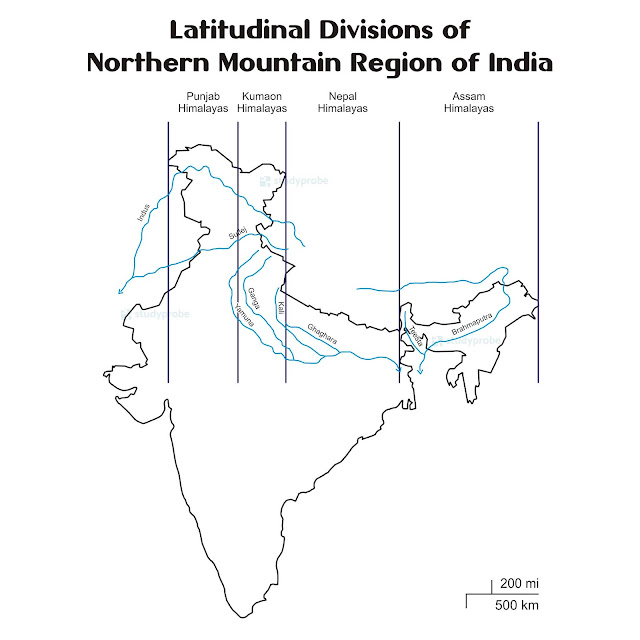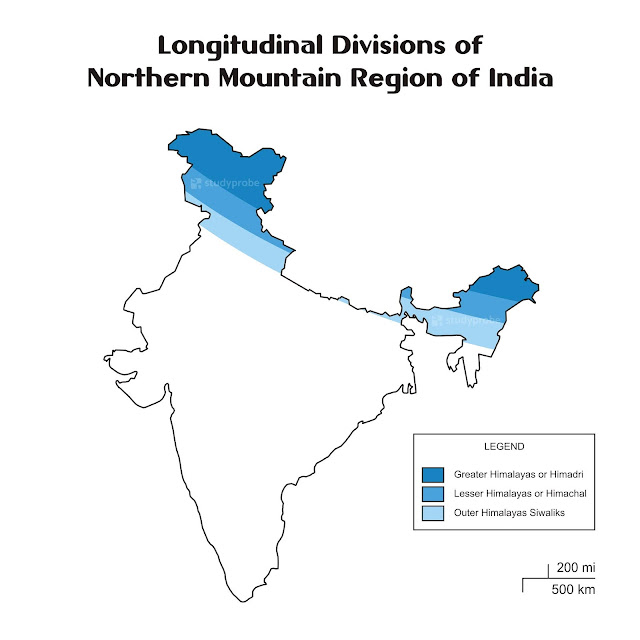1. Introduction
2. Longitudinal Divisions
- Greater Himalayas or Himadri,
- Lesser Himalayas or Himachal,
- Outer Himalayas or Sub-Himalayan Foothills or Siwaliks.
3. Latitudinal Divisions
- Punjab Himalayas
- Kumaon Himalayas
- Nepal Himalayas
- Assam Himalayas
FAQs
 |
| Image Courtesy : Wikipedia |
The Northern Mountain Physiography of India: An Overview
India having a wide diversity in the context of physiography. Mountains, plateau, plain land, coastal land, etc. act as ornaments of Indian physiography. The topic of discussion, 'Great Mountain Region of India' is lying throughout the northern part of the country. Northern mountains of India has formed centering the Himalayas and its off-shoots and foothills. Near about 70 million years ago, the Himalayan mountain ranges were formed from the Tethys Sea due to the collision between Indo-Australian and Eurasian tectonic plates. It is structurally folded mountain range, as well as largest and youngest mountain range of the world. The mountain ranges and peaks are permanently slow-cloded, hence it is called 'Himalayas' or 'Himadri'. It has stretched throughout the India's administrative divisions, viz. Jammu and Kashmir, Ladakh, Punjab, Himachal Pradesh, Uttarakhand, West Bengal, Sikkim, Assam, and Arunachal Pradesh. The Himalayan mountain range is separating the Indian subcontinent from the Tibetan Plateau. This physiographic division can be divided according to two types of extents of the mountain range : Longitudinal divisions, and Latitudinal divisions.
Longitudinal Divisions
From the context of longitudinal division, northern mountain physiography of India consists of three parallel ranges of the Himalayas, namely :
- Greater Himalayas or Himadri,
- Lesser Himalayas or Himachal,
- Outer Himalayas or Sub-Himalayan Foothills or Siwaliks.
These above mentioned three classes have been elaborated in the following :
Greater Himalayas or Himadri
The highest elevated ranges and the northern most parts are known as ‘The Greater Himalayas’ or ‘Himadri’. This range is oldest than others. Mainly the metamorphosed form of primary sedimentary rocks are found in this region. Average elevation of this range is 6,500m. from mean sea level. Highest peak of the world, Mount Everest (8,848.86m.) is situated in this range; though it does not belong to the part of India. Its summit point is situated on the international border between Nepal and China.
The second largest peak of the world, Godwin Austin or K2 (8,611m.), is situated in greater Himalayas. Kanchenjunga (8,586m.), Nandadevi (7,816m.), Nanga Parbat (8,126m.) are other important peaks of Greater Himalayas. Kanchenjunga is the highest peak of India, and ranks 3rd in the world. There are several passes in the region, e.g., Zoji La Pass in Jammu and Kashmir, Baralacha La in Sikkim, etc. The Ganges, Yamuna, Gandak, Indus, Kosi etc. have originated from these ranges.
Lesser Himalayas or Himachal
As the Lesser Himalayas or Himachal belongs between greater Himalayas and outer Himalayas, hence it is also called the Middle Himalayas. Average elevation of this range is about 3000m. from mean sea level. The rocks found in this range of Himalayas are sedimentary rocks. This includes various types, such as, marl, dolomite, greywacke, siltstone, shale, limestone, etc. Notwithstanding metamorphic rocks are also found in the rock structure, especially due to high compression. This range is covered by dense vegetation. Tropical deciduous forests are found in slightly low rainfall regions of comparatively lower slopes of this region. For instance, Pir Panjal range, Dhauladhar, Nag Tibba, etc. There are number of beautiful lakes around Nainital.
Outer Himalayas or Sub-Himalayan Foothills or Siwaliks
It is the southern most part of Himalayan mountain ranges. The elevation of this range is the lowest than others; varies between 600m. to 1,500m. from mean sea level. Hence it is known as Sub-Himalayan Foothills or Outer Himalayas or Siwaliks. There are several broad valleys in this foothill region. These valleys are known as 'Doon Valleys', such as, Dehradun.
Latitudinal Divisions
 |
| Fig.: Latitudinal Divisions of Northern Mountain Region of India |
The Himalayas can be classified into four divisions according to the latitudinal extents. The rivers which have originated from the Himalayas, demarcated the mountain range into four regions. From west towards east, the divisions are :
- Punjab Himalayas : Between the river Indus and Sutlej.
- Kumaon Himalayas : Between Sutlej and Kaali river.
- Nepal Himalayas : Between Kaali and Teesta river.
- Assam Himalayas : Between Teesta and Dihang river.
FAQs
1. What is the northern mountain of India?
The Himalayas, the Karakoram Mountains, and the North-Eastern mountain ranges collectively constitute the majestic Northern mountains.
2. What are the major physical features of the northern mountains of India?
The Himalayas stand as the dominant geographical feature of northern India, boasting a range of physical features. The Greater Himalayas are adorned with a pristine coat of perpetual snow and ice, giving rise to numerous towering peaks in this awe-inspiring region. Southward from the Greater Himalayas lie the enchanting Lesser Himalayas, renowned for their picturesque hill stations like Shimla, Nainital, Ranikhet, and Mussoorie. Embracing the southernmost edge of the Himalayan range are the striking Shivalik Hills, known by different names across various regions, such as Jammu Hills in Jammu and Mishmi Hills in Arunachal Pradesh, among others.
3. What are the northern mountains in a short note?
The majestic Himalayas, a relatively youthful and dynamically formed range of folded mountains, extend along India's northern borders. These awe-inspiring mountains span in a magnificent west-east orientation, reaching from the Indus River in the west to the Brahmaputra River in the east. Reverently referred to as the Northern Mountain Wall of India, these geological wonders stand tall, marking a splendid natural boundary for the country.
4. What are the division of northern mountains of India?
The Himalayas are characterized by three prominent sections: the Himadri, Himachal Himalayas, and Shiwaliks. The Shiwaliks stretch across the Eastern and Northeastern regions of Punjab, running parallel to the borders of Himachal Pradesh.
5. What is the importance of northern mountains?
The Northern mountains serve as the origins of significant rivers such as the Ganga. These natural barriers have historically played a vital role in safeguarding against invasions. Additionally, they play a crucial role in inducing rainfall by obstructing winds in North India and shielding the region from the cold winds originating in Central Asia.



Post a Comment
Please do not enter any spam link in the comment box